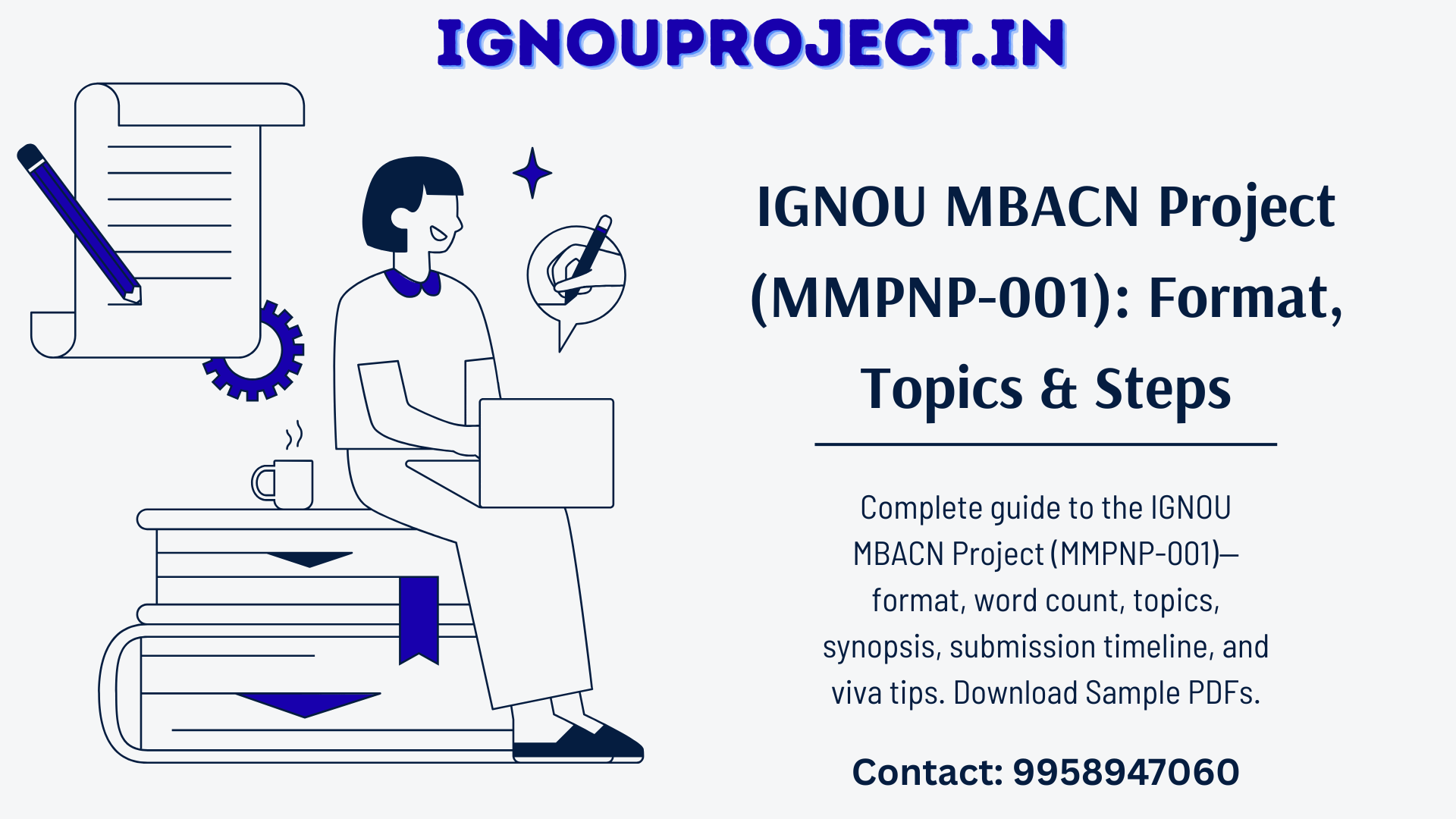The IGNOU MBACN Project (Master of Business Administration in Construction Management) requires every learner to complete the 8‑credit Project Course MMPNP‑001. This capstone integrates managerial concepts and the nuances of construction practices to solve real‑world problems. The project must be planned, supervised and submitted according to the University’s rules. The following guide explains the objectives, format, ethical requirements, topic ideas, proposal development, data analysis, submission procedures, viva preparation and other resources learners need to successfully complete their MBACN project.
Key Highlights & Quick Summary
- 8‑credit capstone: MMPNP‑001 is equivalent to two courses and aims to apply multidisciplinary knowledge to a construction‑management problem.
- Formal structure: The report typically spans 50–60 pages (around 18 000 words) and follows chapters such as Abstract, Introduction, Literature Review, Methodology, Data Analysis, Discussion and Conclusion.
- Synopsis & guide approval: Students must prepare a synopsis specifying objectives, methodology and supervision; this is submitted to the Regional Centre or Learning Management System (LMS) for approval.
- Submission window: Learners can submit their project report any time; however, evaluation and results align with term‑end examination cycles (January–June or July–December).
- Viva: Evaluators may conduct a viva‑voce to assess understanding MMPNP-001 project work.
Table of contents
What Is the IGNOU MBACN Project (MMPNP‑001)?
The IGNOU MBACN project course is a mandatory requirement that demonstrates a learner’s capacity to integrate construction‑management theories and research methods to analyse a practical problem. It carries 8 credits, equivalent to two courses, but learners register for it as a single course. The project encourages independent inquiry under a qualified supervisor and contributes to the degree grade.
Credit value, objectives, learning outcomes
- Credit value: 8 credits; counts as one course in registration but equivalent to two courses in workload.
- Objectives: To develop research skills, apply management concepts to construction problems, critically review literature and provide evidence‑based recommendations.
- Learning outcomes: Upon completion, learners should be able to identify a research problem, conduct a literature review, design and implement a methodology, analyse data and present findings effectively.
Who should choose which project type
Students may opt for different project types depending on interests and constraints:
- Case study: Suitable when access to a single organisation is available; examines a real‑life construction project or firm.
- Field study: Ideal for learners wanting to survey multiple organisations or stakeholders; involves quantitative or qualitative data collection.
- Inter‑organisational study: Applies when comparing practices across companies, supply chains or public agencies.
- Desk‑based research: Appropriate for learners with limited field access; synthesises existing literature and secondary data.
- Innovation design/project planning: For those interested in designing a management information system, safety plan or training module.
Selecting a type should align with personal interests, professional context and available resources; supervisors can advise on feasibility.
Chapter‑Wise Format & Word Limit in MBACN Project
The MBACN project report should be typed, double‑spaced and bound. IGNOU suggests a length of about 50–60 pages or approximately 18 000 words (excluding appendices). The following chapter‑wise structure covers mandatory and optional components.
Abstract (200–300 words)
Provide a succinct overview of the study including problem statement, methodology, key findings and implications. Although brief, it must convey the essence of the project and attract readers’ attention.
Introduction & Rationale (800–1 000)
The introduction contextualises the problem. Explain the construction‑industry background, discuss why the topic is important, define research questions and objectives and highlight expected contributions. The rationale should justify why the study is needed, referencing gaps in existing knowledge.
Literature Review (1 500–2 000)
Conduct a critical appraisal of national and international literature related to the topic. Organise the review thematically or chronologically. Summarise theories, models and empirical findings; identify controversies and research gaps. Evaluate how previous studies inform your research design.
Methodology (design, sampling, tools, ethics)
This chapter outlines how the study was conducted:
- Research design: Choose between qualitative, quantitative or mixed methods. Justify design choices.
- Sampling: Describe population, sampling frame and technique (random, stratified, purposive). Mention sample size and rationale.
- Data collection tools: Explain instruments (questionnaires, interviews, observations) and pilot testing. Attach tools in annexure.
- Data sources: Clarify primary and secondary sources and reliability.
- Ethics: Discuss informed consent, confidentiality and data security. Adhere to IGNOU’s plagiarism rules and obtain institutional permissions.
Data Analysis & Results (tables/figures guidance)
Present the data logically. Use descriptive statistics (mean, median) and inferential tests (t‑test, ANOVA, regression) as appropriate. Include well‑labelled tables and figures. Use charts to illustrate trends. Provide narrative that highlights significant results without repetition. In qualitative studies, provide coded themes and illustrative quotes. Keep tables simple and refer to them in the text.
Discussion & Limitations
Interpret findings in light of objectives and literature. Discuss whether hypotheses were supported and why certain results emerged. Reflect on practical implications for construction management. Acknowledge limitations such as small sample, measurement bias or time constraints. Suggest how future research could address these limitations.
Conclusion & Recommendations
Summarise major findings, emphasise their contribution to theory and practice, and answer the research questions. Provide actionable recommendations for industry practitioners, policymakers or organisations. Ensure recommendations are feasible and aligned with evidence.
References & Annexures
Use an approved referencing style (APA or MLA). List all sources cited in the report. Include annexures such as questionnaires, interview guides, approval letters, consent forms and raw data summaries. Ensure annexures are numbered and referenced in the main text.
Chapter–Word Count–Evaluation Weight Table
| Chapter | Suggested word count | Typical evaluation weight (approx.) * |
| Abstract | 200–300 | 5 % |
| Introduction & Rationale | 800–1 000 | 10 % |
| Literature Review | 1 500–2 000 | 20 % |
| Methodology | 1 200–1 500 | 15 % |
| Data Analysis & Results | 1 200–1 500 | 20 % |
| Discussion & Limitations | 600–800 | 10 % |
| Conclusion & Recommendations | 500–700 | 10 % |
| References & Annexures | As required | 10 % |
*Evaluation weight is indicative; learners should confirm with their supervisor or Regional Centre for exact distribution.
Approved Citation & Ethics
IGNOU emphasises academic integrity. The IGNOU MBACN project must be original; plagiarism is strictly prohibited. Similarity checks may be employed, and excessive overlap could lead to rejection. When collecting data, obtain informed consent, respect confidentiality, and adhere to data‑protection regulations. Secure permissions from organisations or institutional review boards (IRB) when required. Cite sources accurately using the approved referencing style (APA or MLA) and avoid self‑plagiarism. Students should also acknowledge contributions from the supervisor and any funding or assistance.
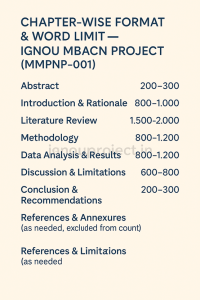
Figure: Chapter Wise Format & Word Limit in MBACN Project
50+ IGNOU MBACN Project Topic Ideas (Fresh & Feasible)
- Impact of Building Information Modelling (BIM) adoption on project delivery times.
- Role of lean construction techniques in cost reduction for residential projects.
- Assessing digital twin technologies for facility management.
- Safety culture and accident rates among medium‑scale contractors.
- Influence of green building certification on property values in metropolitan areas.
- Risk management strategies in public–private partnership infrastructure projects.
- Factors affecting the productivity of construction labour in urban projects.
- Effectiveness of prefabricated components in reducing waste.
- Analysis of supply‑chain disruptions due to geopolitical events on construction material prices.
- Evaluation of quality control practices in high‑rise construction.
- Adoption of drone technology for site monitoring and progress tracking.
- Impact of smart contracts and blockchain on project transparency.
- Comparative study of schedule control techniques in highway projects.
- Assessment of sustainable procurement practices in government infrastructure contracts.
- Examining the role of leadership styles in project team performance.
- Influence of remote work and digital collaboration tools on project coordination.
- Women’s participation in construction management roles: barriers and enablers.
- Analysis of contract dispute resolution mechanisms and outcomes.
- Effect of climate change adaptation measures on construction project budgets.
- Application of value engineering for cost optimisation in mega‑projects.
- Study of noise pollution mitigation methods near construction sites.
- Review of building code compliance in small and medium enterprises.
- Adoption of modular construction in affordable housing schemes.
- Socio‑economic impact of large infrastructure projects on local communities.
- Evaluation of occupational health programs for construction workers.
- Stakeholder engagement strategies in heritage conservation projects.
- Customer satisfaction with post‑handover services in residential complexes.
- Impact of digital marketing on the sales of construction firms.
- Analysis of cash‑flow management practices among small contractors.
- Effectiveness of training programs for upskilling construction labour.
- Sustainability assessment of different roofing materials.
- Role of government policies in promoting circular economy practices in construction.
- Study of energy‑efficiency retrofits in public buildings.
- Comparative analysis of project scheduling software tools.
- Impact of occupant feedback on design modifications.
- Integration of Internet of Things (IoT) devices for predictive maintenance.
- Evaluation of risk perception among project stakeholders.
- Assessment of waste management strategies on construction sites.
- Role of corporate social responsibility in construction industry branding.
- Analysis of tendering processes and their fairness.
- Cybersecurity challenges in smart construction projects.
- Impact of foreign direct investment on infrastructure development.
- Use of simulation tools for site logistics planning.
- Evaluation of training needs among female construction workers.
- Assessment of 3D‑printing technology readiness in India.
- Pricing strategies of construction materials during inflationary periods.
- Knowledge‑management practices in construction firms.
- Study of project governance frameworks and their effectiveness.
- Impact of off‑site construction on project sustainability.
- Analysis of community engagement in highway expansion projects.
- Evaluation of digital procurement platforms for supplier selection.
- Assessment of cost overrun factors in bridge construction.
- Human resource challenges in mega infrastructure projects.
- Effectiveness of integrated project delivery (IPD) in Indian context.
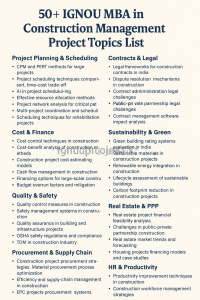
Figure: 50+ IGNOU MBA in Construction Management Project Topics List
Learners should refine topics further and align them with personal interests and available data.
IGNOU MBACN Synopsis (Proposal) Writing—Step by Step
- Select a topic and supervisor: Choose a relevant topic and approach a qualified faculty member or professional for supervision. Supervisors must have a management degree and at least five years’ experience.
- Draft the proposal: Include an introduction, rationale, objectives, methodology, limitations and references. Write in clear, concise language.
- Prepare ethics section: Explain how you will obtain consent, maintain anonymity and mitigate risks. Mention any institutional approvals required.
- Attach supervisor bio‑data: Provide the supervisor’s brief CV and consent letter if demanded by the Regional Centre.
- Submit for approval: ODL students send the proposal to the Regional Director; online students upload it on the LMS. Await approval before commencing research.
- Revise if needed: Address feedback promptly. Conduct pilot studies to refine tools before final data collection.
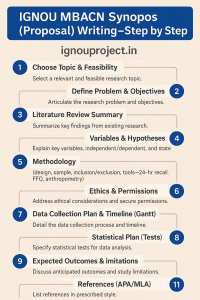
Figure: IGNOU MBACN Synopsis (Proposal) Writing—Step by Step
Learn how to make an IGNOU MBACN Synopsis
Data Collection & Statistical Analysis in MBACN Project
Data Collection
- Primary data: Use surveys, interviews, observations or experiments. Ensure instruments are valid and reliable. Pretest questionnaires and refine based on pilot feedback. Obtain permissions from organisations and guarantee confidentiality.
- Secondary data: Collect data from published reports, journals, government statistics, company records, or online databases. Evaluate authenticity and relevance.
- Ethical considerations: Provide information sheets and consent forms to participants. Secure data storage and limit access to authorised personnel only.
Statistical Analysis
- Descriptive statistics: Calculate measures of central tendency (mean, median, mode) and dispersion (standard deviation, variance). Summarise data using frequency tables and charts.
- Inferential statistics: Use hypothesis testing to draw conclusions. For differences between groups, apply t‑tests or ANOVA; for relationships between variables, use correlation or regression analysis. Non‑parametric tests (Mann–Whitney U, chi‑square) may be used when data assumptions are violated.
- Software tools: SPSS, MS Excel, R, Python or any statistical package can be employed. Document versions and include output in annexures.
- Interpretation: Present results with p‑values and confidence intervals. Avoid overstating significance. Use visual aids (bar charts, histograms) to enhance comprehension.
IGNOU MBACN Project Submission & Key Dates
The submission procedure differs between ODL and online modes. Students should follow the instructions applicable to their mode.
Where/how to submit (regional centre/online portal)
- ODL students: Submit the bound MBACN project report along with the approved synopsis to the Registrar (Student Evaluation Division) at IGNOU headquarters. Include the certificate of originality signed by the learner and supervisor. Attach the approved proposal and dispatch them by post or in person. Simultaneously, send a soft copy (PDF) if required.
- Online students: Upload the final MBACN project report, scanned certificate of originality and synopsis through the LMS. Ensure file formats and sizes adhere to portal specifications.
Common errors to avoid (formatting, missing certificates)
- Missing supervisor’s signature on the certificate of originality.
- Exceeding the word limit or omitting mandatory chapters.
- Using inconsistent referencing styles or copying content without citation (plagiarism).
- Failing to include annexures like questionnaires or raw data.
- Submitting the report after the evaluation cut‑off date for the desired term‑end exam.
- Not binding the report or using poor‑quality printing.
Timeline graphic
The schedule of operations indicates when study material is dispatched, counselling is conducted, assignments are due and examinations occur. The chart below contrasts the January–June and July–December cycles based on the handbook.
Interpretation: For the January–June cycle, study material dispatch begins in mid‑December; counselling runs from January to May; assignments are submitted by 30 April; feedback is given by mid‑May; and term‑end exams take place in June. For the July–December cycle, equivalent activities occur about six months later. Project reports can be submitted at any time, but evaluation will align with these cycles.
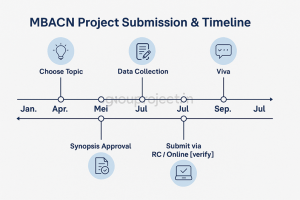
Figure: MBACN Project Submission & Timeline
Viva Preparation for MMPNP 001
Although the MBACN project is mostly evaluated through the written report, the evaluator may recommend a viva‑voce. To prepare:
- Review the entire project: Understand every section, especially methodology, data analysis and conclusions.
- Anticipate questions: Evaluators may ask about research objectives, sampling rationale, ethical considerations, significance of results and limitations. Practise answers concisely.
- Relate theory to findings: Demonstrate how literature guided your research design and how results support or challenge existing theories.
- Prepare to defend methodology: Justify statistical tests and assumptions. Be ready to explain why alternative methods were not chosen.
- Stay calm and professional: Dress formally, maintain eye contact if the viva is in person or ensure a stable internet connection if online.
Downloadable Resources
Learners may need templates and guidelines. Suggested resources include:
- IGNOU MBACN Project Guidelines / Handbook
- IGNOU MBACN Project Synopsis Sample PDF
- MMPNP 001 Project Sample PDF in MBACN
- IGNOU MBACN MMPNP 1 Project Topic List
These resources are usually available through the Regional Centre or LMS; learners should download the latest versions.
FAQs – IGNOU MBACN Project for MMPNP 001
What is the credit value of MMPNP‑001?
It carries 8 credits and is equivalent to two courses but registered as one.
How long should the MBACN project report be?
The report should be about 50–60 pages or around 18 000 words, excluding appendices.
Do I need to submit assignments for the MMPNP-001 project course?
No. The project course is evaluated solely on the report and, if applicable, the viva.
Where do I submit the MBACN synopsis?
ODL students send it to the Regional Director; online students upload it via the LMS.
Can the supervisor be from related to construction management industry?
Yes, provided they hold a management degree and at least five years of relevant experience.
Conclusion
The IGNOU MBACN project (MMPNP‑001) is a rigorous yet rewarding endeavour that integrates theoretical learning with practical problem‑solving in construction management. This guide has outlined the structure, ethical considerations, topic ideas, proposal development, data analysis, submission procedures and viva preparation.
By adhering to the university’s project guidelines and maintaining academic integrity, learners can produce a project that not only satisfies programme requirements but also contributes to the improvement of practices within the construction industry.
👉 To learn more about project writing in MBACN, check out our blogs:
Need Help in IGNOU MBACN Project (MMPP 001)?
Completing the MMPNP‑001 project is a significant milestone in the MBACN programme. By following the approved format, selecting a feasible topic, adhering to ethical standards and planning your submission, you will not only meet academic requirements but also develop practical research skills that can advance your career in construction management.
Start early, consult your supervisor regularly and use the resources provided. For personalised assistance or professional guidance, connect with your Regional Centre or authorised project support services.
Get expert assistance, topic suggestions, and ready-to-submit project reports now!
👉 [Contact Us] | 🌐 Visit: ignouproject.in

